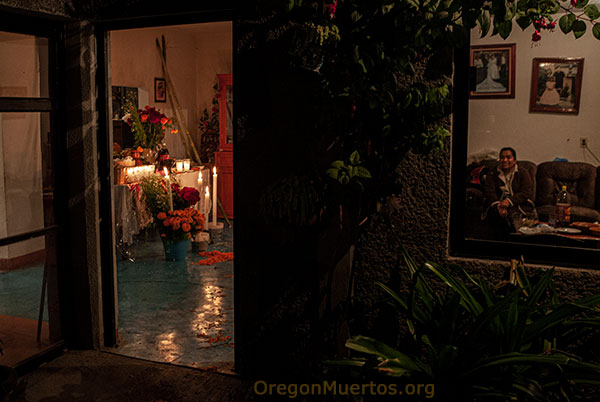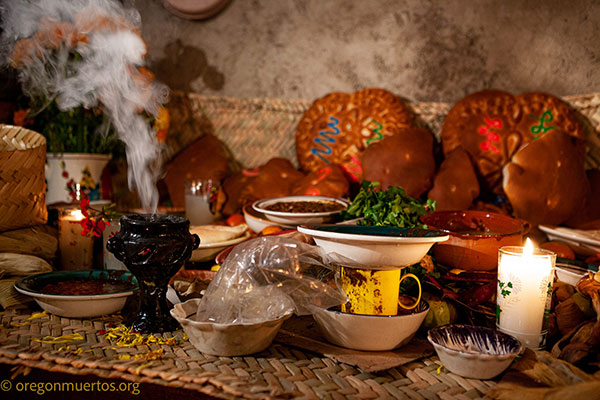What Is an Ofrenda?
The dialogue between two worlds.

From the Neanderthal, to more recent past civilizations, to our own modern times, the belief in life after death has been present. Each culture has traditions and customs in place to reckon with this belief. The biggest offering known in history meant to accompany a deceased person was found in China in 1974. In order to achieve immortality, the first Qin emperor of China, Qin Shihuang (c. 221-206 B.C.E) immediately began to plan his burial. One of his first mandates after ascending to the throne at age thirteen was to build an underground palace with an army outfitted to accompany him into death. This army included over 7,000 life-sized terracotta warriors, horses, chariots, and weapons intended to protect him in the afterlife. He was deeply concerned with the deeper mysteries of the universe and looked to the cosmos as a guide for crossing over to an immortal existence.





Mexican Ofrendas Have a Traditional Structure
You can create your own Ofrenda for the Day of the Dead. The Ofrendas for this celebration have some basic elements. Read on to learn about them and how to include them in your offering.
Food!
Yes, that is a basic essential. It seems that since the beginning of humanity, we have believed that the departed require food for their travels beyond this realm. It’s one of the most important elements. In the case of the Day of the Dead tradition, including food in the Ofrendas is a way to honor and welcome those who are visiting us on this special day of memories. Their favorite foods and beverages are part of the offering.
Traditionally you will find fruit of the season, bananas, oranges, apples, sugar canes, and so on. The specific customs around food included may be different depending on the city or town. Some people cook full meals, while others just place small portions.
And of course, don’t forget about the sugar skulls! Sweets are very important. Traditionally people gift sugar skulls with their name on the forehead. A special bread, Pan de Muerto, is also included. This sweet, round bread is made with a circle and limbs designed on top to represent death, and dusted with sugar and sometimes cinnamon. There was no wheat in the Americas before the arrival of the Spanish. However, in Otomi culture, a special kind of corn bread was made in the shape of a triangle. It is still made today using wheat flour. The triangular shape of the bread is a leftover influence from colonial times.
Salt
Include a small plate with just salt. This is an important element for life as we know it. In the traditional thinking, it is believed the salt will prevent the body of the departed from breaking down as it travels.
Water
A glass of water is indispensable in the Ofrenda. Any person who makes a journey needs to satisfy their thirst! This is especially true if they are coming from far away. In addition, water represents one of the four elements along with fire, wind and the soil.
Flowers
The official and traditional flower is the Cempazuchitl – the Aztec Marigold. This flower, which comes in shades of brilliant orange and yellow, is known in Mexico as “flor de muertos” (flowers of the dead). It has been used for this celebration since the time of the Aztecs. These flowers only bloom in the fall, and their smell is very distinctive.
In modern times, the marigold flower has many applications in the agricultural sector as a natural insect repellent. It is used to extract pigments, and also has medicinal properties and is used in home remedies.
The name Cempazuchitl is of Nahuatl origin. It comes from two words: Cempohualli, meaning twenty, and Xochitl, meaning flower. Flowers of twenty petals. This is a sacred number for the Aztec culture as twenty is the number of days that create a month in the pre-hispanic calendar. However, if you live in a northern climate it will be hard to find marigolds at this time. You can place any kind of flowers on your Ofrenda.
(Source: Virtual Center of Studies Danzas Mexicanas)
Candles and Votive Candles
The light and the fire of candles represent the impermanence in this world (see Macario). At the same time they are the guides for the spirits to find their home. Traditionally families place a candle per visitor. This is a custom in indigenous groups, however it is not a rule.
Copal
This is a resin of vegetable origin widely used among the Mesoamerican people in medicine and religious practices. The smoke of the copal is used to purify. It is believed to keep malevolent spirits away.
Papel Picado
The best description for this special art form is “paper shaped in the form of a stencil.” In Mexico, colorful tissue paper (known as Chinese paper) is used to depict scenes of trade work, portraits, and names. The original version of this practice was done using amate, a type of tree bark paper made in Mexico since pre-colonial times.
The Levels
The most common arrangement for the Ofrendas is three levels: ground, life, and the afterlife. Usually, this is where you will place the portraits of the family, friends and visitors. However, nine and thirteen levels are also very significant, as nine levels is the number for the Mictlan, and thirteen is the number of life. The Mexica / Aztec year is called Xiuhpōhualli, and is divided into eighteen months of twenty days each. Within this count, 260-days is dedicated to the ritual cycle: thirteen months of twenty days each, called Tōnalpōhualli.
Español
Dialogo entre los vivos y los muertos.
En la ofrenda del día de muertos, hay elementos que son imprescindibles por el significado de su presencia.
Sal
Agua.
Velas y Veladoras
Flores
Calaveras.
azúcar o chocolate,
Copal e incienso.
Pan de Muerto.
Papel picado.
November 1 Music Night
Music Night 8:00pm to 12:00pm Mitlantecutli welcome to his house. (Codex Borgia) Huehca Omeyoacan November 3/ 11:30am @ The Zone Music Producer Joe Alt and Dj Betroxx In addition to the exhibit of day of the dead come and enjoy a night of dance and music. Date:...
Sunnyside Environmental K-8
Sunnyside EnvironmentalYoung volunteers and Oregon Muertos Sunnyside Environmental K-8 last year contribution showed in Cafe United.Sunnyside Environmental K-8 Skeleton and AlebrijeSunnyside Environmental K-8 best students this year are painting a skeleton in addition...
Armory 2024
Día de Muertos ExhibitFine art contemporary works the ongoing evolution of the Day of the Dead tradition.October 18 2024 - November 2 Wednesday-Sunday Hrs: 12:00pm - 9:00pm In this exhibit, artists share their interpretations of the cultural roots and evolution...



